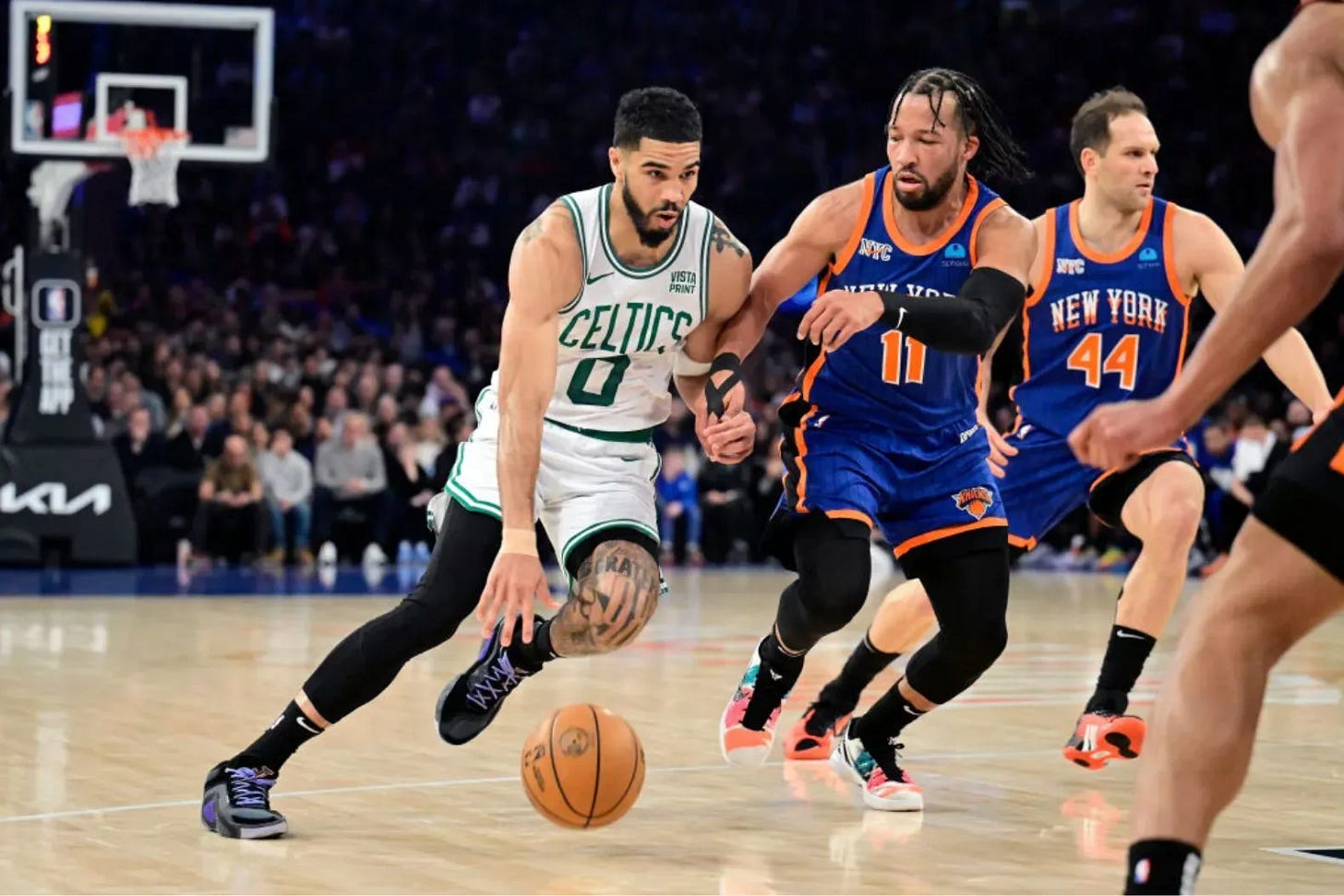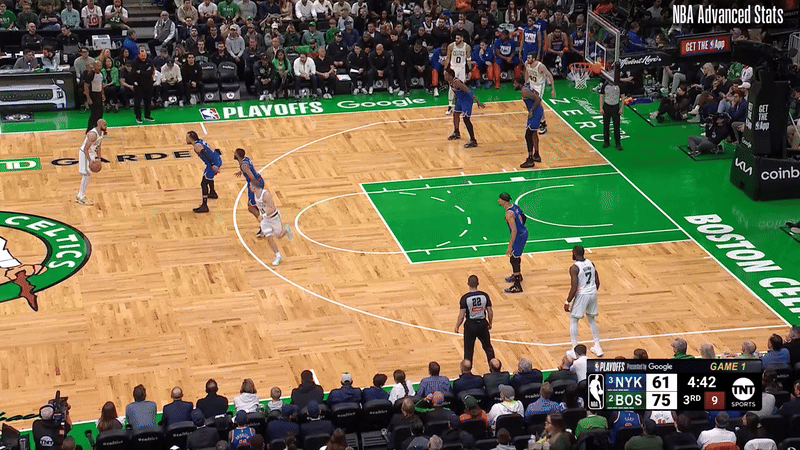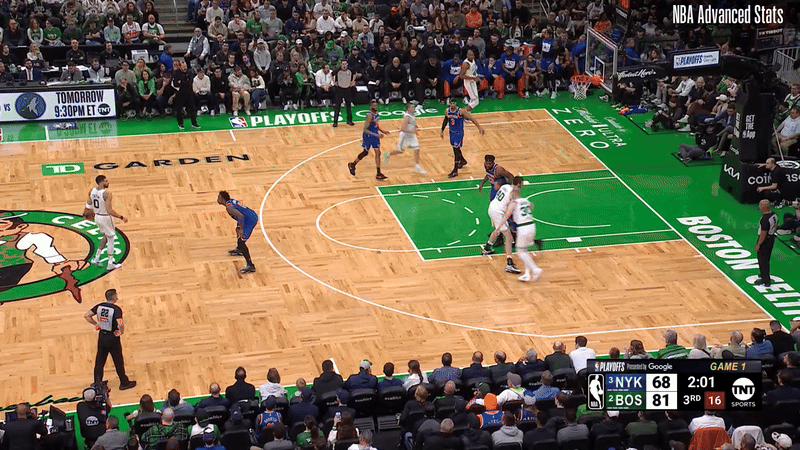Celtics take the bait in loss to Knicks
Live by the three. Die by the three.
*Reminder that the Discord server is now live! Join here.*
Live by the three.
Die by the three.
That has been the Boston Celtics' mantra throughout the Joe Mazzulla experience. The Celtics get up more threes than everyone else, and in turn, they make more threes than everybody else.
Brad Stevens has constructed a roster that is overflowing with highly talented three-level scorers. Everyone can guard their yard, create offensive looks, and knock down their shots.
Still, playing with such a high volume on the perimeter comes with a distinct counterbalance: shooting variance.
Sometimes, shots just don't fall. And in the most perplexing of ways, when one member of the Celtics roster goes cold, it spreads throughout the team like wildfire.
We know this.
We've seen it unfold on multiple occasions.
Yet, we can't explain it. Off nights are contagious, apparently.
Throughout the 2024-25 season, Mazzulla's team has adjusted when the threes aren't falling. They embraced the mid-range game, punished the rim, and found wrinkles to exploit within a defense – then, when they felt in rhythm, they tried their luck from deep – often with encouraging results.
That's where things fell apart against the New York Knicks on Monday. The Celtics came into the second half with an ice cold shooting touch. Nothing was falling. Yet, rather than making the adjustments we've become accustomed to seeing, they kept firing away, hoping to turn the tide while out of rhtyhm and playing unrewarding basketball.
"In those moments, when the other team has got momentum, we can't just fire up threes to break up the momentum," Jaylen Brown said in his postgame news conference. "You gotta get to the free throw line, get to the paint, get to the basket. Maybe an easy two. Hit some free throws. And maybe the next three-pointer feels a little bit better. I feel like we just settled in the second half, a lot."
Boston took 12, yes 12, two-point attempts in the entire second half. They took just over three times as many shots on the perimeter (37). During Brad Stevens' head coaching years, he would consistently urge the need to hit singles. Yet, despite holding a near 20-point lead, the Celtics kept searching for a home run. Then, the Knicks pulled on a loose hanging thread, and everything crumbled.
Unlike the Orlando Magic, who actively looked to take away the three-point line, the Knicks baited Boston. They found ways to take away the glass. They gave up shots they were willing to live with, held the Celtics to one-shot possessions, and then got out on offense.
"Orlando kinda took the three-point line away," Brown said. "It felt like [the Knicks] were kinda daring us to shoot, like they wanted us to shoot those shots. We didn’t make them tonight. But, I felt like we had a ton of good looks. Some, maybe we forced up, we settled for sure...That's an abnormal game for us when it comes to shooting the basketball.
At the time of writing this newsletter, the NBA has not yet released its tracking data for Monday's games. However, I'm willing to hazard a guess that everyone except Jaylen Brown will be appalled to see the malnourished data surrounding their drives, especially in the second half.
The Knicks were content to sag off shooters. They coaxed the Celtics into believing they were taking quality shots, all while taking away driving lanes, staying home on shooters and being in position to rebound.
Take a look at the above clip. Derrick White is among the best decision-makers in the NBA. He rarely makes the wrong read. We've lauded him for his professionalism and selflessness for the past 18 months now. So, when he steps into a long three, it's likely because he believes that's the best quality shot within the scheme of how the Celtics approach things on offense. He's not calling his own number for the sake of it.
Jalen Brunson is sagging off. Tatum, Luke Kornet and Sam Hauser are all being picked up by their defenders. There's no off-ball movement. So, with little advantage being created elsewhere, White chooses the path of least resistance, he takes the lightly-contests / open three.
He took the bait.
What's worse is that White is converting just 34.1% on pull-up three's this season. His value on the perimeter comes off the catch, where he's draining shots at a 40.9% clip. The Knicks would know this. Granted, the players on the court are unlikely to know the actual number, but they will for sure understand that White shooting off the dribble is less of a threat.
So, the Knicks dare him to take that shot. They live with the results. And with each passing miss and each passing single-shot possession, New York grew in confidence.
It's the same story in this action. The step-in three is going to be available for Tatum throughout this series. He found success with that shot during the second quarter, especially when the screen was coming off a ram action.
The Knicks had Brunson showing on the switch before recovering, ensuring Tatum couldn't iso on him. However, as the Knicks began to bait shots, they changed their scheme a little. Watch how Brunson slightly bumps Tatum on his show, before he recovers back to his man. OG Anunoby then rotates over to close out and pressure the shot.
After getting bumped, Tatum finds himself in a room. So, he steps into a three-point shot at the logo. Like White, that shot is probably one step too far out for Tatum, especially on the pull-up rather than the catch. Anunoby's presence, as he's closing out hard, adds another layer of difficulty to Tatum's shot, and thus, it clanks off the rim.
"Probably, sometimes we settled," Tatum said. "I think for myself, I could've put some more pressure on the rim. But there was a lot of times where we felt like we got some really, really good looks and just couldn't convert."
The two clips above are illustrations of how the Knicks looked to bait the Celtics into taking shots that fit their profile, but were slightly outside of the usual scope in terms of range and how they were generated. If Boston was knocking those looks down, the Knicks would have pivoted to a different strategy. But the Celtics didn't knock them down, so New York stayed the course.
That meant, that by the time the Celtics did decide to start attacking downhill, the Knicks were feeling it, and were rotating with aggression and belief.
Look at the activity from the New York Knicks on defense. pic.twitter.com/R9Fy1J1L5x
— Steve Jones Jr. (@stevejones20) May 6, 2025
The Celtics didn’t lose to the Knicks because they shot threes or because the Knicks continue to bait them into those shots. only shot threes throughout the second half — and continued to do so while cold, without the pace, mulit-layered screeing, or off-ball movement that typically powers their offense.
We’ve seen Boston weaponize the three-point line with terrifying efficiency. But it only works when it’s part of a broader offensive ecosystem — one that includes rim pressure, physicality, and adaptability. On Monday, they abandoned that balance.
The postseason is about adjusting. Mazzulla's group has proven they can evolve game-to-game. But this loss is a reminder: in-game adjustments are key, and it shouldn't need Mazzulla or the coaching staff to preach the importance of penetration. This group are the reigning NBA champions. They should be past getting caught up in trying to keep hit home runs, especially as the game starts to slip away.
This wasn’t a blueprint for how to stop the Celtics. The Knicks didn't stumble onto some cryptic tablet deep in a dungeon somewhere. Instead, the Knicks found a way to make the Celtics forget what makes them elite. Because the moment they started prioritizing shot volume over shot quality, the entire operation began to wobble. And at this stage of the season, any team is capable of pouncing on that stubbornness every single time.




